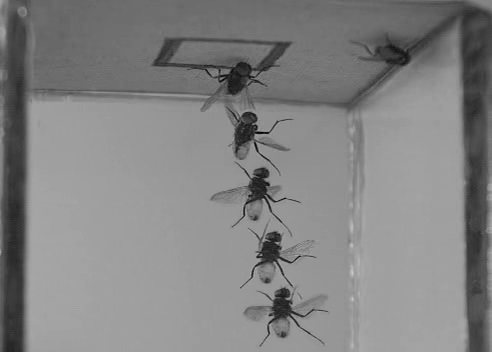A new study from the National Centre of Biological Sciences (NCBS), Bangalore, has thrown some light on the mystery of how flies can land on vertical and upside-down surfaces. Sanjay Sane’s group at NCBS has shown that fly landing maneuvers have two distinct modules of behavior – deceleration and leg extension. The team has found that deceleration or slowing down, is like a reflex action, and sets in at a distance proportional to the speed of flight. In other words, at higher flight speeds, deceleration sets in earlier and further away from the landing surface. The second behavior, leg extension (comparable to airplanes lowering their landing wheels), however, does not follow this pattern.
God in his wisdom made the fly,
And then forgot to tell us why.
-Ogden Nash
But then some curious scientists beheld
How these insects flew.
Such a complex task, yet the flies excelled!
With minute brains and neurons few.
“How do the wings work so well?” they cried,
“How does it land on a wall?”
“How does it know when to apply its brakes?”
“For landings horizontal, upside-down, or vertical?”
So why God made the fly, is a question
Out of date and quite trifling.
What’s exciting to scholars now, is how
We can copy the flies’ engineering.
According to an aircraft pilot, the thought process for landing an airplane begins even before the plane takes off. Weights are calculated, the weather is evaluated, runway lengths are compared, and a lot of planning actually goes into achieving a successful landing.
Yet a common housefly can land on almost any surface – horizontal, vertical, and even upside-down – in less than the blink of an eye.
How do flies do this?
Sanjay Sane’s laboratory at the National Centre for Biological Sciences (NCBS), Bangalore, may have some answers. In a study published in PLoS one, Sane’s group has now shown that fly-landing maneuvers have two distinct modules of behavior – deceleration or slowing down, and leg extension. The first modular behavior during landing is deceleration, which is triggered at a distance proportional to the speed of flight. At higher flight speeds, deceleration sets in earlier and further away from the landing surface. The second behavior, leg extension (comparable to airplanes lowering their landing wheels), however, does not follow this pattern.
Although scientists have long worked on flight and landing behaviors in flies, this study is the first to do so in free-flying houseflies.
“Flies begin to decelerate at a very specific time-point, precisely 40 milliseconds before an impending collision with the landing surface. Now, although this has been known for quite some time, most studies on insect flight, especially those on landing behavior, have usually used tethered insects. This is obviously not a natural situation, and so, we wanted to see landing behavior in flies that were not tethered – after a bout of natural flight,” says Sane.
“Also, most work on landing in insects focused on filming landings on either a vertical surface or a horizontal surface. Our work is one of the first studies to record the similarities and differences between how an insect can land on both walls and ceilings,” adds Sujay Balebail, the first author in the publication that describes this work.
To understand how flies land on horizontal or up-side down surfaces, the researchers used minimal yet elegant experimental setups. These consisted of simple brightly lit plexiglass boxes with well-defined landing surfaces edged in black. Flies introduced into these chambers were filmed using two synchronized high-speed cameras. Recordings of the flights were digitized and analyzed to determine when these flies began deceleration and leg extension prior to landing.
“Designing this setup was quite the most difficult part of this work. Flies are incredibly intelligent organisms, and we tried lots of ideas to get them to behave like we wanted them to in our experimental chambers. Nothing worked,” says Sane. “Then, one day, while observing a fly in my living room at home, I noticed that it seemed to prefer landing on the edges of shadows – this sparked off the idea to use a black-edged visual cue to stimulate landing. We tried it in our setups, and it worked!” he adds.
Close analysis of the flies’ landing maneuvers not only confirmed a well-studied phenomenon – that flies begin to decelerate farther away from the landing area when they are flying faster – but also revealed something new. Landing, it turns out, is a complex behavior that occurs in two ‘steps’. The first step is the deceleration, which begins 40 milliseconds before the fly is likely to collide with the landing surface. If flies missed this time point to begin deceleration, they lost control of the landing and exhibited ‘head contact’ landings, where their heads bumped into the landing area. The second step is the leg extension, which, however, does not always occur during the onset of deceleration.
“Flies follow strict rules when it comes to slowing down. However, the moment at which they begin sticking out their legs before touchdown is variable. The slowing down portion of landing appears more like a reflex, whereas the leg-extension part appears more like a ‘decision’,” says Balebail.
The findings from these experiments have already borne some interesting scientific fruit. Inspired by the approaches used in this study, a recent publication by Liu et al. in October this year used a similar setup to crack the mystery of how bluebottle flies can land on upside-down surfaces.
“Insects are amazing organisms. Flying insects like houseflies and dragonflies are more agile then our best airplanes. Moreover, they can land on any surface, oriented in any particular direction, something which human-made flying objects struggle to achieve,” says Balebail. “I believe that understanding both the mechanics and algorithms/strategies used by insects to land on different surfaces could aid us in designing aerial vehicles which can land safely with limited human control,” he









0 Comments